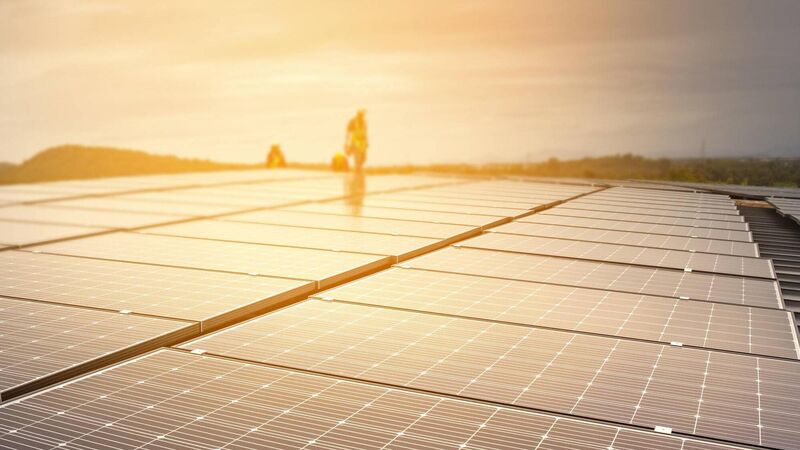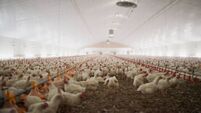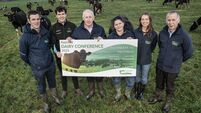Policy gaps being filled for Irish farmers who want to install solar on idle roofs

“In terms of farming, really there were a lot of barriers and restrictions up to now; planning, grid connections, and the ability to sell back.”
Supporting the appropriate technologies being installed on farms is becoming increasingly important, and solar-energy technology is where there is “a lot of interest” among Irish farmers, according to Mel Gavin of the AgroRes project.
Over the years, policy gaps that stood in the way of on-farm adoption have now been filled, he said.
However, farmers interested in installing solar panels may be uncertain as to where to start.
Michael Norton, head of commercial sales with Pinergy Solar Electric, said they have been installing solar PV in Ireland for the last 10 years.
“Things have changed over that time, in terms of system sizing, barriers, and everything like that,” Mr Norton told the recent Energy and Farm Business Show, held at Gurteen College in Co. Tipperary.
“One thing to say about the older systems is that they’re probably generating free electricity today; because they were installed several years ago, they have been generating electricity, making savings, and now the electricity coming from those systems is actually free, which is very powerful in the energy crisis we’re in now.
“In terms of farming, really there were a lot of barriers and restrictions up to now; planning, grid connections, and the ability to sell back.”
New policy from the Department of Environment, Climate and Communications — the Micro-generation Support Scheme — is “the biggest thing that’s happened to solar in Ireland ever”, Mr Norton said.
“What it means is that people can now sell back excess electricity, where, before, they were actually giving it away for free if they had excess,” he said.
“So, this means that solar is now viable for most businesses and farms and especially dairy farms.”
On a dairy farm, milking tends to be in the morning and in the late afternoon or evening.
“Whereas, with solar PV, you’re actually generating between those two areas of demand: Between the times you’re actually using electricity, so at midday,” Mr Norton said.
“So, a dairy farm is nearly the most tricky situation to size a solar PV system for, because you’re actually generating electricity at the times you’re not really using it; you’re still using it, but not as much; you’ve actually used some in the morning and in the afternoon.
“So, when it comes to sizing PV systems, with the new policy that allows people to export, what we’re seeing is that the wisest thing to do is to install the largest system you can.
“And you might think that’s something someone in sales might say, but you’re actually restricted.”
Mr Norton said that the largest system they can install on a dairy farm is up to the size of your grid connection.
“Everybody has an electricity bill, and, normally, on the top right-hand corner of that bill you’ll have what’s called a maximum import capacity, which is basically the size of your grid connection,” he said.
“It could be 15kVA or 29kVA, so that’s our limit, actually, of how much solar we can install.
“You might have acres of roof space, but we have to stop there.
“kVA is basically kW, so if you compare to a household appliance, a kettle is 1kVA— it just means how much power can you actually draw from the grid — so if you’ve got a grid connection of 15kVA, that means you can draw at any time 15kW; you can plug in 15 kettles if you want, but no more; that’s the limit of your grid connection.”
That’s the first thing: How much solar they can actually put on your roof.
“And from there we can tell, based on the orientation of your roof space, how much you’ll actually generate,” Mr Norton said.
“kWh is what you actually pay for; that’s what your electricity bill is.
“If you’re really close to the coast, you’re probably over 1,000kWh, because there’s less cloud cover, but, in general in Ireland, it averages out at about 900kWh,” Mr Norton said.
“It’s generally pretty stable, and actually, because a lot of shed roofs are fairly low pitch, the orientation only changes the output by a couple of per cent, so even east, west, is probably, maybe 10% less production than south-facing, so they’re very viable roof spaces as well.”
After assessing how much energy can be generated, they then compare that to how much you’re actually using.
“We look at 12 months of your bills and say you’re using 40,000kWh a year, you’ve a maximum import capacity of 15kVA, we can put, say, 15kW of solar, which will generate, maybe, 13,000kWh a year, which is roughly 30% of your bill,” Mr Norton.
“So, that’s kind of where it’s at with dairy farms. Now, the farm could have a lot more roof space to install a lot more solar.
“Normally, most of the time your grid connection is what you need. It could be 15kVA, it could be 29kVA, it could be anywhere in between, but if you’re using electricity based on that, it’s normally big enough for what you need.
“If you’re putting in a solar system that might generate 100% of your annual usage, it means your system is probably way too big, because solar generates mainly in the summer — March to September — that’s when 80% of the generation happens.
“And it generates only in the day and peaks at midday, so it’s very concentrated. It works out pretty well. Generally, you’re offsetting somewhere between 30%/40% of your annual usage,” Mr Norton said
Mel Gavin advised that one of the simple, initial things a farmer can do when considering solar is to install their own electricity monitor, which he said is “very simple” to fit.
“That doesn’t need to be expensive; you don’t need an electrician,” Mr Gavin said.
“You can get one called an Efergy Engage Hub [Kit]; there’s also a company called OWL that do them, and they come in single phase and three phase.
“What you need for both of these is access to your meter, access to the live wires; there’s a clip-on cable that goes on there, it sends a signal.
“You need a wifi signal that is accessible from your meter to your wifi router, and you will get a live recording of how you’re using electricity.
“You don’t need to worry about writing it down every day: It’s recorded on a web-based service. And then you have an accurate profile of your daily use.
“That’s a great place to start, particularly for dairy farms.”
The Micro-generation Support Scheme is targeting support for 380mW of installed microgeneration capacity, to contribute to the target of up to 2.5GW of solar renewables under the Climate Action Plan.
Depending on panel size, that equates to over one million solar panels, on 70,000 buildings.
Under the scheme, non-domestic applicants, such as businesses, farms, schools, and community buildings, will be able to apply for a grant for installations up to 6kWe, at the same levels as domestic customers, according to the Department of the Environment, Climate, and Communications.
Grant support for domestic installation of solar PV is available, and it is expected that around mid-September the grant will be extended to non-domestic applicants.
Also through the scheme, non-domestic applicants will be able to apply for a Clean Export Premium (CEP) feed-in tariff to support installations between 6.1kWe and 50kWe.
In 2022, the CEP feed-in tariff will be €0.135/kWh.
The CEP will be fixed for 15 years, and eligible volumes will be capped at 80% of generation capacity to encourage self-consumption.
Supports through the scheme will be reduced over time from 2024, to take account of reducing system costs.
Rory Somers, of the Department of the Environment, Climate and Communications, told the event at Gurteen College that the microgeneration scheme is not “targeting the farming sector particularly”.
“There is a TAMS grant in place in the farm sector and there are improvements proposed now around the TAMS grant.
“TAMS is obviously farm-focused; the microgeneration support scheme is broader.
“The TAMS grant itself is more generous than the grant that we’re offering from our department, but, one of the catches with TAMS is you’re not allowed to export.”
At the Energy and Farm Business Show, Minister for Agriculture Charlie McConalogue told the Irish Examiner that “any opportunities we can take, any new technology we can adopt, needs to be used” to reduce agriculture’s emissions.
He told the event that agriculture can play a key role in helping the country achieve its 51% economy-wide greenhouse-gas reduction targets.
“On-farm renewable energy generation activities of our farmers contribute in a positive way to the decarbonisation of the energy system, providing a diversification opportunity for farmers who remain committed to playing their part in achieving our national-climate-change emission-reduction goals,” he said in his speech.
Mr McConalogue said that agriculture will contribute to displacing fossil fuels-based energy “through utilising solar panels to produce electricity, forestry biomass to displace heat, and opportunities arising from the development of an anaerobic digestion industry”.
Minister for Environment, Climate and Communications, Eamon Ryan, who attended the recent event, has said that solar PV remains the “most accessible and scalable of renewable energy technologies” for farmers.
The show at Gurteen College brought together stakeholders from across the industry, focusing on a wide spectrum of topics, such as renewable energy in agriculture, alternative agriculture, forestry, and on-farm tourism opportunities.
CLIMATE & SUSTAINABILITY HUB











